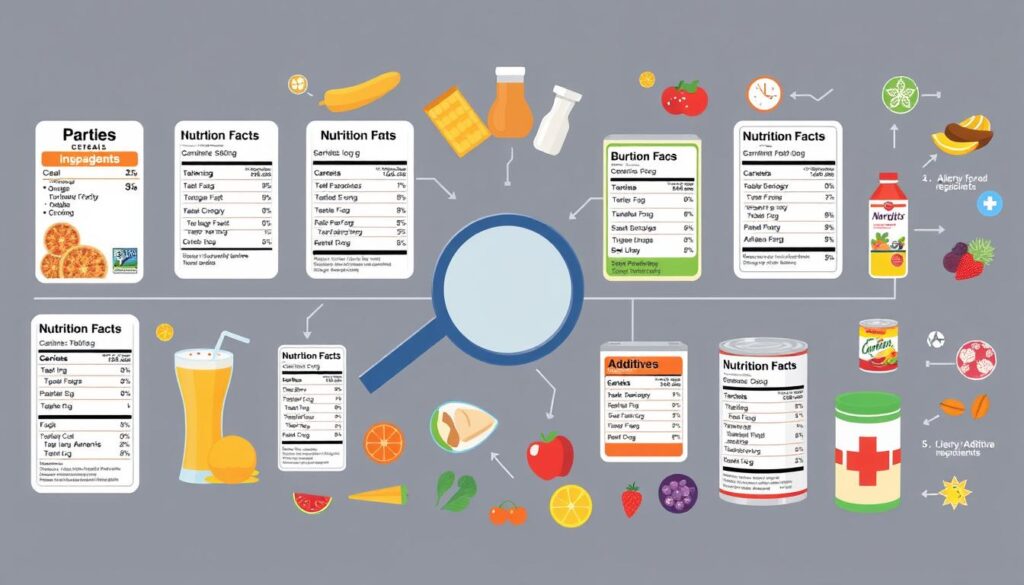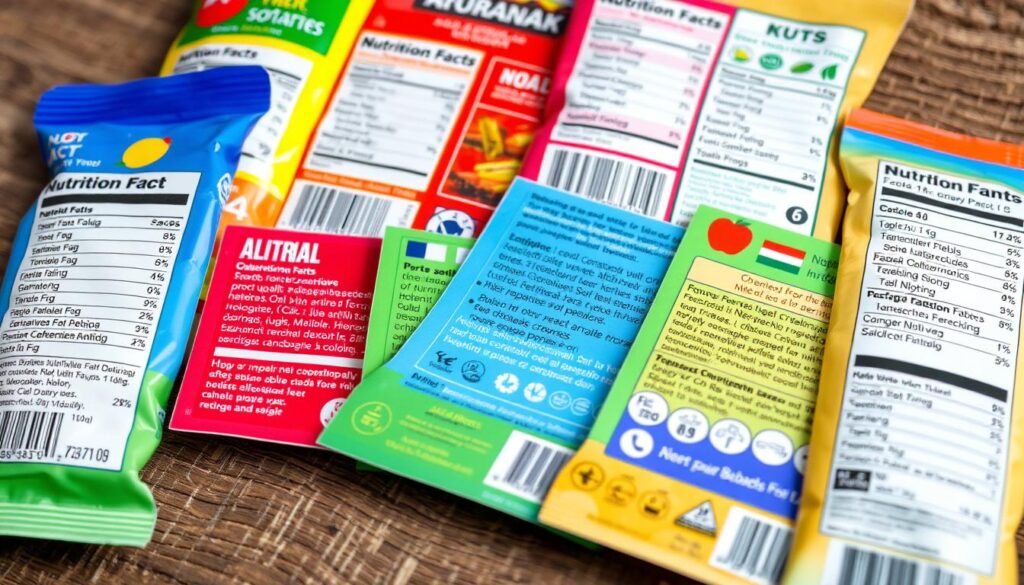Ever looked closely at the ingredients in your favorite foods? It can be confusing with all the strange names and additives. But, knowing what’s in your food can help you make better choices for your health.
Let’s explore food labels and ingredients together. We’ll teach you how to read labels like a pro. This way, you can choose foods that fit your diet and preferences. Whether you have food allergies or just want to avoid artificial stuff, we’ve got you covered.
Key Takeaways
- Discover the hidden meanings behind common food label terms
- Learn how to identify potential allergens and cross-contamination risks
- Understand the difference between natural and artificial ingredients
- Explore the clean label movement and its impact on product transparency
- Discover how technology can help you navigate food labels with ease
Understanding Food Labels: Your Guide to Product Transparency
We all want to know what we eat. That’s why it’s key to understand food labels. We’ll explore common terms and where to find important info for smart choices.
Common Label Terms and Their Meanings
Terms like “nutrition facts” and “allergen information” might seem confusing. Let’s break down the most critical ones:
- Nutrition facts – This panel shows calories, vitamins, and minerals in the product.
- Allergen information – It tells you if the product has common allergens.
- Clean label – It means the product has simple, known ingredients without artificial stuff.
Where to Find Critical Product Information
It’s vital to know where to find important info on labels. The main details are usually in:
- The Nutrition Facts panel, on the side or back
- The Ingredients List, also on the side or back
- The Front of Package, for claims like “allergen-free” or “clean label”
Legal Requirements for Food Labeling
Food makers must follow strict labeling rules. This helps you make better choices. Key rules include:
| Requirement | Description |
|---|---|
| Nutrition Facts Panel | Standardized format detailing caloric, vitamin, and mineral content |
| Allergen Labeling | Clear identification of the top food allergens present |
| Ingredient List | Complete listing of all components in the product |
Knowing these label basics helps you shop smarter. You’ll choose products that fit your nutrition facts, allergen information, and clean label needs.

The Complete Ingredients List: Breaking Down What You’re Really Eating
Looking at the ingredient list helps us understand what’s in our food. But, it can be hard to make sense of all the terms. Don’t worry, we’re here to help you understand those labels better.
The order of ingredients matters a lot. The first ones are the most, and the last ones are less. This tells us a lot about the ingredient sourcing and natural ingredients in a product.
Unveiling the Mysterious Ingredients
Let’s explore some common ingredients in packaged foods:
- Whole Food Ingredients: These are foods like fruits, veggies, grains, and nuts. They give us important nutrients.
- Processed Ingredients: These are foods that have been changed, like oils, flours, and sweeteners. The change can be big or small.
- Food Additives: These are added to improve product composition. They can be synthetic or natural, like preservatives, flavors, and colors.
Knowing the difference between these can help you choose better foods.
| Ingredient Type | Examples | Potential Benefits/Concerns |
|---|---|---|
| Whole Food Ingredients | Apples, broccoli, quinoa, almonds | Rich in vitamins, minerals, and fiber. Minimally processed. |
| Processed Ingredients | Vegetable oil, wheat flour, cane sugar | May have reduced nutritional value. Varying levels of processing. |
| Food Additives | Sodium benzoate, artificial colors, MSG | Potential health concerns, depending on the individual. |
Knowing what’s in our food helps us make better choices. This way, we can meet our health and wellness goals.

Hidden Sources of Allergens and Cross-Contamination Risks
For those with food allergies or sensitivities, knowing hidden sources of allergens is key. We’ll look at the top food allergens to watch out for. We’ll also explore how food is made and how to read food labels safely.
Top Food Allergens to Watch For
- Peanuts
- Tree nuts (e.g., almonds, cashews, walnuts)
- Shellfish
- Eggs
- Milk
- Wheat
- Soy
- Fish
Manufacturing Processes and Allergen Controls
Many foods are made in places that handle many ingredients, including common allergens. It’s important to have strict rules and allergen controls to avoid cross-contamination. Look for signs that show they manage allergens well.
Reading Labels for Allergen Safety
Reading food labels carefully is the best way to spot allergens and stay safe. Check the ingredient list and also for “may contain” or “processed in a facility that also processes” statements. These can hint at allergens even if they’re not listed as main ingredients.
| Top Food Allergens | Common Hidden Sources |
|---|---|
| Peanuts | Baked goods, candy, cereals, sauces, and even some non-food items like cosmetics |
| Tree Nuts | Baked goods, nut butters, trail mixes, and certain types of seasonings and spices |
| Shellfish | Seafood, sauces, and imitation seafood products |
| Eggs | Baked goods, mayonnaise, pasta, and some processed meats |
| Milk | Baked goods, chocolate, processed meats, and even some medications |
| Wheat | Breads, pasta, cereals, and even some sauces and dressings |
| Soy | Baked goods, vegetable oils, and processed meats or meat substitutes |
| Fish | Seafood, Worcestershire sauce, and some types of salad dressings |
Navigating food labels is essential for those with dietary restrictions or food allergies. Understanding hidden sources of allergens and potential cross-contamination risks can help you make informed and safe choices.
Decoding Chemical Names and Artificial Additives
Understanding food labels can be tough, especially with long chemical names. Knowing these ingredients is key for those wanting clean label and natural ingredients in their product composition. Let’s break down some common additives you might see.
Food additives do important jobs like keeping food fresh and improving taste. Sodium benzoate and xanthan gum are examples. They might sound scary, but they’re used a lot to keep food safe and tasty.
- Artificial Colors: Dyes like Red 40 and Yellow 5 make food look better. But, they might not be good for health and are often skipped by those looking for natural ingredients.
- Preservatives: Stuff like BHA and BHT keep food from going bad longer. But, some people worry about their safety.
- Emulsifiers: Things like lecithin mix water and fat for a smooth feel. Some folks choose to avoid them.
More brands are now offering clean label options. By learning about these names, you can choose foods that fit your health goals.
Understanding the purpose and potential impact of food additives is the first step towards making more mindful choices about what we put in our bodies.
| Ingredient | Purpose | Potential Concerns |
|---|---|---|
| Sodium Benzoate | Preservative | May form benzene when combined with vitamin C |
| Artificial Colors | Enhance visual appeal | Linked to potential health issues, especially in children |
| Xanthan Gum | Thickener and stabilizer | Generally considered safe, but potential digestive issues for some individuals |
Natural vs. Artificial Ingredients: Making Informed Choices
In today’s world, the debate over natural vs. artificial ingredients is big. We all want food that tastes good and is good for us. Let’s dive into this topic and help you make choices that fit your needs.
Benefits of Natural Ingredients
Natural ingredients come from whole, unprocessed sources. They have vitamins, minerals, and antioxidants that help our bodies. These natural ingredients are less processed, keeping more of their nutrients. They also offer a healthier eating experience.
Many people choose clean label products because they seem purer. These products use natural ingredient sourcing.
Understanding Synthetic Alternatives
Synthetic or artificial ingredients are made to act like natural ones. They might be cheaper or work better, but they lack the natural benefits. It’s key to know how they affect our diet and health.
Impact on Health and Wellness
Choosing natural over artificial can greatly affect our health. Natural ingredients are full of nutrients and don’t have synthetic additives. But, the effects of artificial ingredients are still being studied.
As we make choices, we must think about the risks and benefits. This helps us pick options that support our health goals.
Deciding between natural and artificial ingredients is personal. It depends on what we like, our dietary needs, and our health goals. By understanding these choices, we can make better decisions. This way, we nourish our bodies and minds.
Clean Label Movement: The Push for Simpler Ingredients
In today’s world, people want to know what’s in their food. This has led to the clean label movement. It’s changing the food industry a lot.
The clean label movement is all about natural ingredients and simple product composition. People want to see ingredients they know on labels. They don’t like long lists of hard-to-pronounce names.
Food makers have listened to what people want. They’re making their products cleaner. This means removing artificial stuff and using clean label ingredients instead. It’s good for health-conscious shoppers and shows a focus on clean food.
| Benefits of Clean Labels | Challenges for Manufacturers |
|---|---|
|
|
The clean label movement is growing fast. Food companies need to keep up. By being open and simple with their product composition, they can win over health-conscious shoppers. This helps them stay ahead in a changing market.
The clean label trend is not just a passing fad – it’s a fundamental shift in how consumers want to interact with the food they consume.
Plant-Based and Alternative Ingredients: A Modern Perspective
The demand for plant-based diets is on the rise. The food industry is answering with new plant-based ingredients. These ingredients meet different dietary restrictions and tastes. They range from plant-based meats to dairy-free options, giving consumers more choices than ever.
Popular Plant-Based Substitutes
- Soy-based products, like tofu and tempeh, are widely used as meat alternatives.
- Nut-based milks, such as almond, cashew, and oat milk, provide dairy-free options.
- Chickpea and lentil-based proteins are gaining popularity in plant-based burgers and snacks.
- Coconut-derived ingredients, including coconut oil and coconut milk, offer versatile alternatives.
Nutritional Considerations
Plant-based ingredients are great for meeting dietary needs. But, it’s key to look at their nutritional content. Some may not have enough protein, calcium, or vitamin B12 compared to animal products. Reading labels and knowing where ingredients come from helps make choices that support your health.
Environmental Impact
The growth of plant-based ingredients has led to talks about their environmental effects. Many plant-based options have a lower carbon footprint than animal products. This could help make food production more sustainable. As people become more aware of their environmental impact, the food industry may change for the better.
Exploring plant-based ingredients can be for many reasons. It could be for diet, health, or the environment. The modern food world offers many options to fit your needs and tastes. Knowing the benefits and challenges of these alternatives helps you make choices that match your values and lifestyle.
Using Technology to Navigate Food Labels: The Food Scan Genius App
Understanding food labels can be tough. But, the Food Scan Genius app makes it easier. It helps us make smart choices about what we eat.
This app is like a personal guide for food labels. Just scan a barcode, and you get all the details. You’ll know about nutrition, ingredients, and allergens. It’s great for making choices that fit our dietary needs.
Quickly Identify Allergens and Nutrition Facts
The Food Scan Genius app is great for finding allergens. It’s perfect for people with food allergies. It scans labels and shows any allergens, helping us stay safe.
It also breaks down nutrition facts. This makes it easy to compare products. You can pick the best foods for your health.
Personalized Recommendations for Your Dietary Needs
The app does more than just show info. It gives personalized advice based on your diet. It helps you find products that fit your health goals.
| Feature | Benefit |
|---|---|
| Barcode Scanning | Quickly access detailed product information |
| Allergen Identification | Ensure safety for those with food allergies |
| Nutrition Facts Display | Make informed decisions about product selection |
| Personalized Recommendations | Discover alternatives that suit your dietary needs |
The Food Scan Genius app makes grocery shopping easier. It helps us avoid allergens, track nutrition, and choose healthier options. It’s a powerful tool for a smarter shopping experience.
The Future of Food Ingredient Transparency
The demand for clean labels and transparent products is growing fast. This means big changes are coming to how we see food labels. New technologies and changing what people want will lead to better choices for us.
Blockchain technology is becoming a big player in food. Blockchain-powered traceability lets us see where our food comes from. This builds trust and helps us choose better, more sustainable foods.
Augmented reality (AR) food labels are also on the rise. With a quick scan, we can learn all about a product. This includes detailed product composition and nutritional info. It makes choosing clean label options easier and more fun.
The food industry is ready for a big change. With these new tools, we’re moving towards a future where we know exactly what we eat. This will lead to a healthier, more sustainable food world.
“The future of food is one where we can trust what we’re putting into our bodies, and technology will be the key to unlocking that transparency.” – Jane Doe, Food Industry Analyst
Conclusion
As we wrap up our exploration of food labels and ingredients lists, we hope you feel ready to make better choices. Knowing how to read labels and understand ingredients is crucial for your health. It helps you control what you eat and stay well.
The labels and ingredients list show you what’s really in your food. By learning to read them well, you can pick items that fit your diet and values. We’ve shown you how to uncover the truth behind your food, helping you make smarter choices.
Let’s keep pushing for clearer labels in the food world. By asking for simple and honest labels, we can make a big difference. An informed community can lead to a future where our food is always honest and safe.
FAQ
What information can I find on a typical food product label?
Food labels give you lots of details. You’ll find the ingredients, nutrition facts, and allergen warnings. They might also tell you where the product comes from or how it’s made.
How are ingredients listed on the label?
Ingredients are listed by weight, from most to least. The biggest part comes first. This helps you know what’s in the food.
What are some common terms I might see on a food label?
You might see “natural,” “organic,” “non-GMO,” “gluten-free,” and “low-fat.” These terms have clear meanings. They help you understand what the product is like.
How can I identify potential allergens in a food product?
Labels must list the 8 major allergens: milk, eggs, peanuts, tree nuts, wheat, soy, fish, and shellfish. They’ll be in the ingredients or a “Contains” statement.
What is the difference between natural and artificial ingredients?
Natural ingredients come from plants, animals, or minerals. Artificial ones are made in labs. Natural ones are often seen as healthier, but their safety and value can differ.
How can I tell if a product has been processed or contains preservatives?
Look for processed ingredients and preservatives in the list. Names like sodium benzoate, BHT, and high fructose corn syrup are common.
What is the “clean label” movement in the food industry?
The clean label movement is about using simple, recognizable ingredients. Brands are choosing fewer artificial additives. They’re using more natural, whole foods instead.
How can I use technology to help me read and understand food labels?
Apps like Food Scan Genius can scan barcodes. They give you nutrition info, allergen alerts, and ingredient details. This helps you make better choices.





